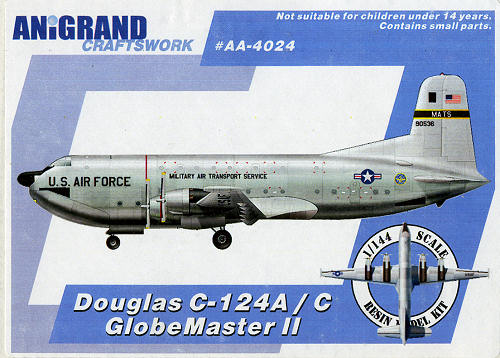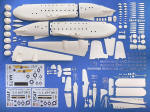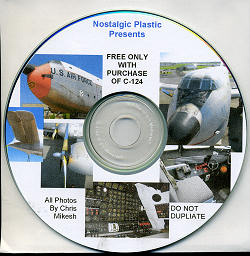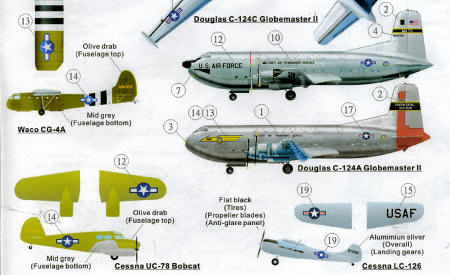| KIT #: | AA-4024 |
| PRICE: | $116.00 from Anigrand USA Free shipping in US/Canada |
| DECALS: | Two options |
| REVIEWER: | Scott Van Aken |
| NOTES: | Resin kit with Waco CG-4A, Cessna UC-78, and Cessna LC-126 kits. |

Anigrand 1/144 C-124A/CGlobemaster II
| KIT #: | AA-4024 |
| PRICE: | $116.00 from Anigrand USA Free shipping in US/Canada |
| DECALS: | Two options |
| REVIEWER: | Scott Van Aken |
| NOTES: | Resin kit with Waco CG-4A, Cessna UC-78, and Cessna LC-126 kits. |

| HISTORY |
After the end of the second World War, the USAAF found the C-74 Globemaster was a very capable and useful aircraft, and began to consider acquiring an improved version proposed by Douglas. It used the same wing, tail and engines from the C-74, but featured a new and enlarged fuselage, as well as clamshell doors in the nose. The result was the C-124 Globemaster II. The YC-124 prototype made its first flight in 1949. The first operational C-124 was delivered in 1950. It provided valuable service in the Korean war, but was deemed too slow in the Vietnam era, so it was earned nickname "Old Shakey". A total of 204 C-124A, and 243 C-124C were built, a turboprop-powered KC-124B tanker variant was considered. In 1970, most the C-124s were transferred to the Air Force Reserve and the Air National Guard. The C-124 was finally replaced by the C-5 Galaxy in 1974.
Just as an aside, the local Reserve unit at Scott AFB that was flying C-119s received C-124s around the late 1960s and flew them for a few years before getting rid of them and converting to an Army Reserve unit. They were eventually flying UH-60s before becoming an Army National Guard unit and moving to Decatur IL, where they are still flying their Blackhawks. Their hangar spaces are now occupied by the 108 ARS, IL ANG and flying KC-135Rs. Interestingly, the Army shop and office spaces were not deemed worthy of the USAF-ANG so in typical Air Force fashion, a huge, multi-million dollar complex of offices and shops were built just for ANG use, complete with expensive and totally needless landscaping so it can look just as pretty as the rest of the base. Your tax dollars at work.
| THE KIT |
 To the delight of many modelers, Anigrand has downsized its huge 1/72 C-124A/C kit to 1/144 scale, a size that fits onto display shelves a lot easier. It is still a large model, but much for of a space saver than it was. I've pinched the parts/decal photo from the Anigrand web site as theirs is so much prettier than how I could arrange it.
To the delight of many modelers, Anigrand has downsized its huge 1/72 C-124A/C kit to 1/144 scale, a size that fits onto display shelves a lot easier. It is still a large model, but much for of a space saver than it was. I've pinched the parts/decal photo from the Anigrand web site as theirs is so much prettier than how I could arrange it.
The fuselage is divided into a fore and aft section with a solid interlock feature that worked so well with their XF-12 'Rainbow' kit and several other larger aircraft. It makes for a very sturdy structure. You'll also note that there are structural reinforcements in the fuselage halves as well. A radar nose is supplied for the C variant. The wings are single piece and my samples had no warping at all. This means that most of the larger castings show air bubbles to some degree. These are mostly in the tips of the fin, horizontal stabilizers and wings. I also found a number of pinholes alongside the engraved detail on the fuselage parts. The fuselage also has a few areas where there are small blobs of resin. These are easily sanded off.
None of these will be difficult to repair and anyone who has done Anigrand kits or those from other makers will have run into these and know how to fix them. It is a bit time consuming but not at all hard to do. The large ones can be dealt with using superglue followed by accelerator and then sanding before the superglue fully cures. Smaller ones can be filled with paint or Mr Surfacer 1000/500 then gently sanded. If you have read the XP-60 article, then you will see that this can be easily fixed. A set of clear bits are provided for the cockpit area and all those windows. The clear resin is well molded and while a bit thicker than injected plastic, can be cleared up even more after installation by coating them with gloss clear paint.
In line with other Anigrand 1/144 kits, there are three additional kits of other aircraft. In this case, there is a Waco CG-4A, Cessna UC-78 Bobcat or 'Bamboo Bomber', and a very nicely done Cessna LC-126. The instructions are a set of nicely done and easy to read photo-representations showing where all the bits are to fit. A couple of detail drawings are also included. Differences between the C-124A and C-124 C are shown as the A models had different engines and props along with no tip heaters or radome. While the kit provides separate prop blades and hub, there is a recess in the hub to accept the stem of each blade, so once parts are cleaned up, assembly should be straight forward.
read photo-representations showing where all the bits are to fit. A couple of detail drawings are also included. Differences between the C-124A and C-124 C are shown as the A models had different engines and props along with no tip heaters or radome. While the kit provides separate prop blades and hub, there is a recess in the hub to accept the stem of each blade, so once parts are cleaned up, assembly should be straight forward.
 To help with building and detailing the kit, Nostalgic Plastic/Anigrand USA has provided a CD-ROM with photos of extant museum aircraft. It is a great addition and reference. Only available from Nostalgic Plastic.
To help with building and detailing the kit, Nostalgic Plastic/Anigrand USA has provided a CD-ROM with photos of extant museum aircraft. It is a great addition and reference. Only available from Nostalgic Plastic.
Decal and painting guide is in full color as shown. The C-124C is in MATS markings near the end of its career. The A model has the nice red tail and I'm thinking it might also be able to have red panels on the wings as well. Pretty much generic insignia and serials for the smaller aircraft though I'm sure some research will turn up some more colorful schemes. Especially the UC-78 (I'm thinking 'Songbird').
| CONCLUSIONS |
You know you have to have it. These are selling as fast as they come in so you know that Anigrand has hit it big with this particular kit. It is a big one for 1/144, but yet it is not really complex. If you have any desire for something as cool as this one, get your order in now.
| REFERENCES |
Kit Instructions
December 2008
Thanks to Nostalgic Plastic/Anigrand USAfor the review kit. Free shipping in the US.
If you would like your product reviewed fairly and fairly quickly, please contact the editor or see other details in the Note to Contributors.